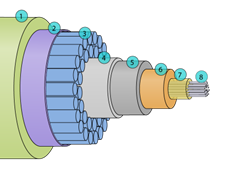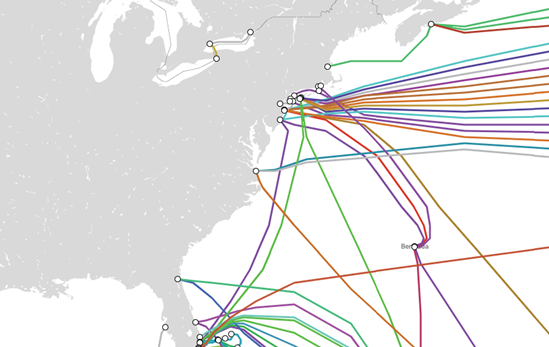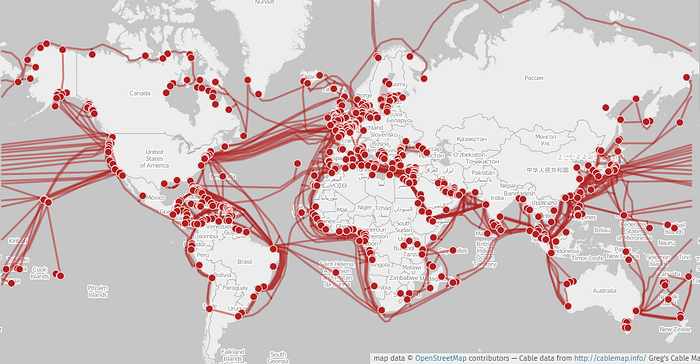Where do people get their internet?
I asked this question in a completely non-scientific poll of some friends and family, and even a few children, and for many the answer seemed to come from the sky:
Satellites.
But while Elon Musk's Starlink system indeed provides supplemental connections for some remote regions — and many satellites provide a backup for military internet use — the world's online networks are largely powered by a complex system of underwater and underground cabling.
According to TechRadar, "Around 380 undersea cables carry over 99.5% of all transoceanic data, running for 750,000 miles across the ocean floor."
These fiber optic wires connect the massive data centers supporting cloud behemoths such as Amazon Web Services, Microsoft Azure, and Google Cloud."
The first submarine communications cables provided near-instant telecommunications links between continents, such as the first transatlantic telegraph cable, which became operational in August of 1858.
By the time glass fiber optic cables were put to use in the mid-1970s, the industry (and infrastructure) of manufacturing, storing, and laying undersea cables was mature and profitable.
Manufacturers knew how to properly protect, power, and insulate undersea cables to achieve the best performance.

The first submarine cable to use fiber optics was TAT-8, which went live in 1988. It reached speeds of 280Mb per second.
Today, the fastest cable is the newly completed transatlantic cable called Amitié. Funded by Microsoft, Meta, and others, it can carry 400 terabits of data per second.
This free, interactive cable map by research firm TeleGeography shows all 380 undersea cables that carry over 99.5% of all transoceanic data, running for 750,000 miles across the ocean floor.

As reliant as we have become on undersea cables, TeleGeography reports that there are over 100 cable breaks per year.
In developed countries, these breaks go largely unnoticed because of redundant systems.
But in some places, a single fiber cable can supply internet for millions of people.
In 2011, an elderly Georgian woman was scavenging for copper to sell as scrap when she accidentally sliced through an underground fiber cable with her spade and cut off internet services to all of neighboring Armenia.
As Georgia provides 90% of Armenia's internet, the woman's unwitting sabotage had catastrophic consequences, plunging 3.2 million people into internet darkness.
Fishing trawlers, anchors, earthquakes, and deep ocean currents are also often responsible for cable breaks. Hell, even sharks take a bite out of them from time to time.
Intentional Russian Sabotage
Perhaps most alarming, Russian spy ships have recently been active in the vicinity of vital undersea fiber-optic cables that power the internet and $10 trillion worth of daily financial transactions.
Combined with Russia's claimed ability to disable American satellites, and their recent creation of a self-contained internet, disrupting information flow for the rest of the world in the event of conflict is likely a key Russian military objective.
In 2015, one particular Russian spy ship named the Yantar was monitored constantly by American spy satellites, ships, and planes as it cruised down America's East Coast.
Why the interest in the Yantar?
Yantar is operated by Russia's secretive Main Directorate of Underwater Research (GUGI) who operate many of Russia's special mission (spy) submarines.
The ship is equipped with two submersible vehicles it can drop off its decks that have the capability to cut cables miles down in the sea.
The two submersibles are the 3-man PR.16810 "Rus" (AS-37 Russia) and PR.16811 "Consul" (AS-39 Consul) which can dive to 6,000m (20,000ft). The crew is housed in a strong spherical chamber in the center and it is equipped with hydraulic manipulators.
James Cameron, eat your heart out.
Last year, NATO's intelligence chief warned, "There are heightened concerns that Russia may target undersea cables and other critical infrastructure in an effort to disrupt Western life, to gain leverage against those nations that are providing security to Ukraine."
Well, of course they would.
According to NATO, 200 of the 400 undersea internet cables are deemed critical for European and American security.
Why wouldn't Russia target these either covertly, or in the event of a shooting war with NATO, overtly?
They can and they will, unless NATO steps up patrolling in key regions.
Having said that, Russian submarine cable sabotage is not a credible threat to internet connectivity within the contiguous US.
Even if every cable connecting to the contiguous US could be sabotaged, domestic communications would still be possible, and the attack would pose a severe threat to Russia's own connectivity.
But the global economy, of which the US is very much a part, would take a hit.
Through that lens, our economic communications and supply chains depend on our connection to a reliable internet.
The United States Department of Defense agrees.
In late 2018, the US Defense Threat Reduction Agency, the US Air Force's Institute for National Security Studies and the Project on Advanced Systems and Concepts for Countering Weapons of Mass Destruction banded together in December to call for research papers analyzing the full scope of the threat.
The internet itself is now being viewed by the US government as a potential weapon of mass destruction akin to nuclear, biological, and chemical weapons.
Funny side note: While proofing this piece with Grammarly, my connection was disrupted prompting me to wonder, albeit briefly, if Russia had cut my connection to Grammarly HQ…
Despite this, because of the well-established infrastructure of the undersea cabling industry, together with our ability to pinpoint breaks in record time thanks to time-domain reflectometry, cable breaks should be able to be repaired promptly, even in the event of war.
So while undersea fiber cables are inherently vulnerable, the risks are mitigated by fast cable repair and an increasing reliance on space-based assets.
Still, it is amazing to think that our livelihoods depend on a 180-year-old communications technology, incrementally improved upon over the years to accommodate our massive data needs today.
The upcoming shift to 5G cellular technology and Internet of Things devices will only increase our appetite for bandwidth.
Because of this, higher-capacity cables are beginning to enter service.
Listen folks, if you like reading this content, now is the time to stop taking reliable internet for granted and start thinking about protecting this amazing resource of human ingenuity.
Our global economy depends on it.
Stay frosty-
Слава Українi

